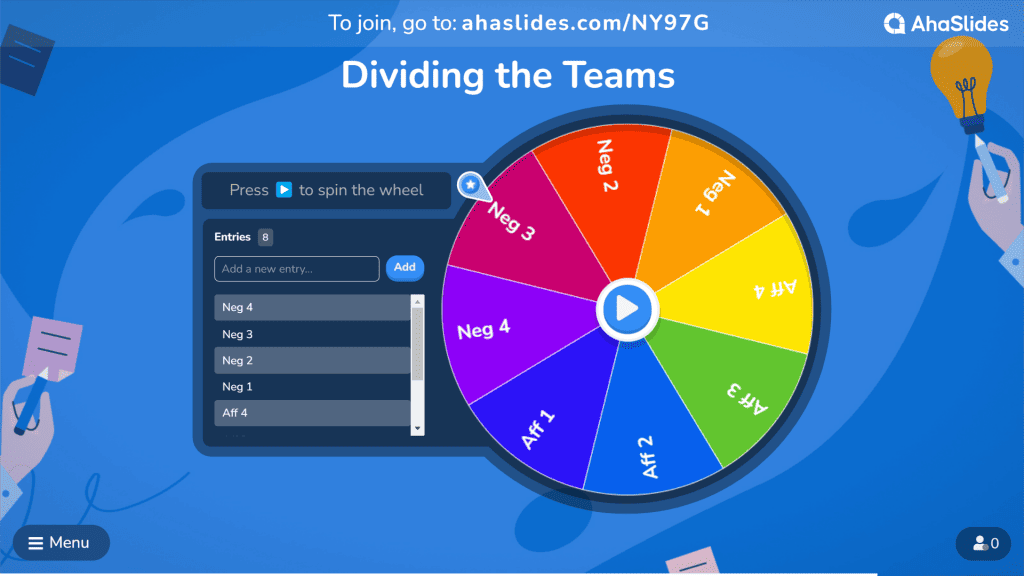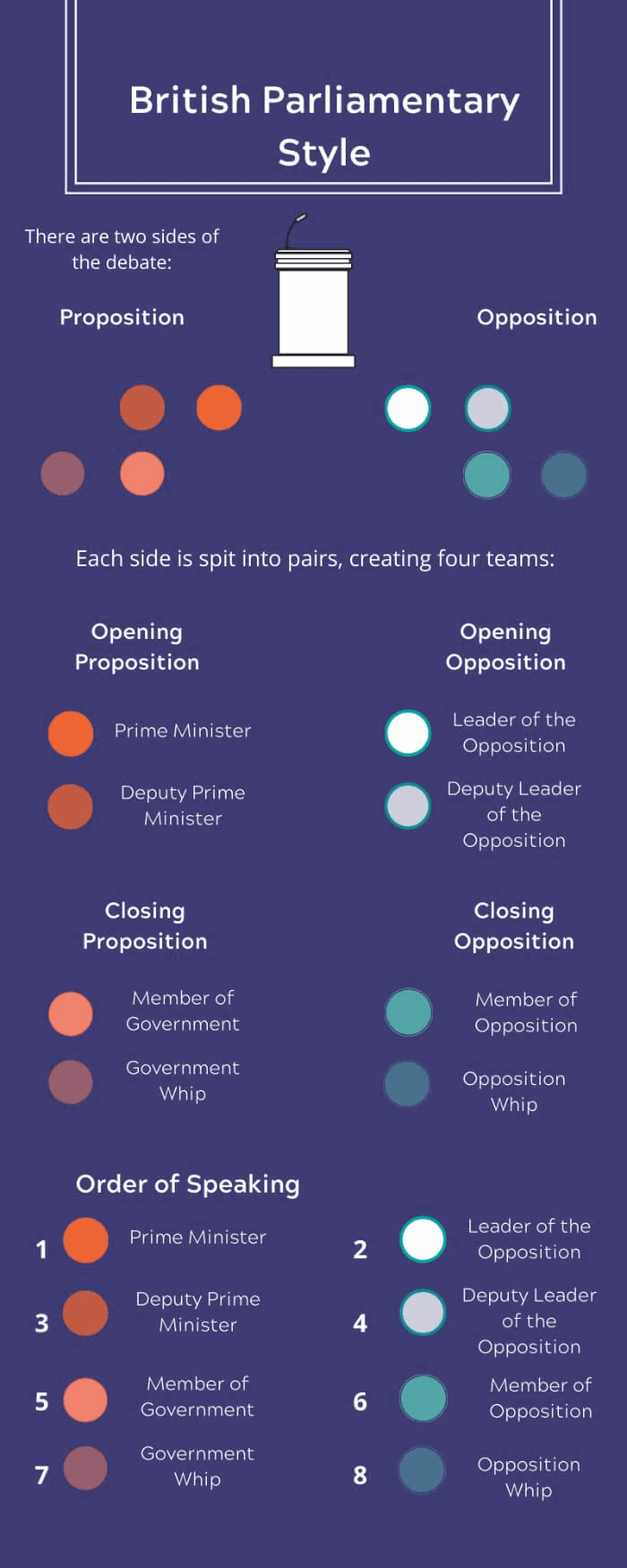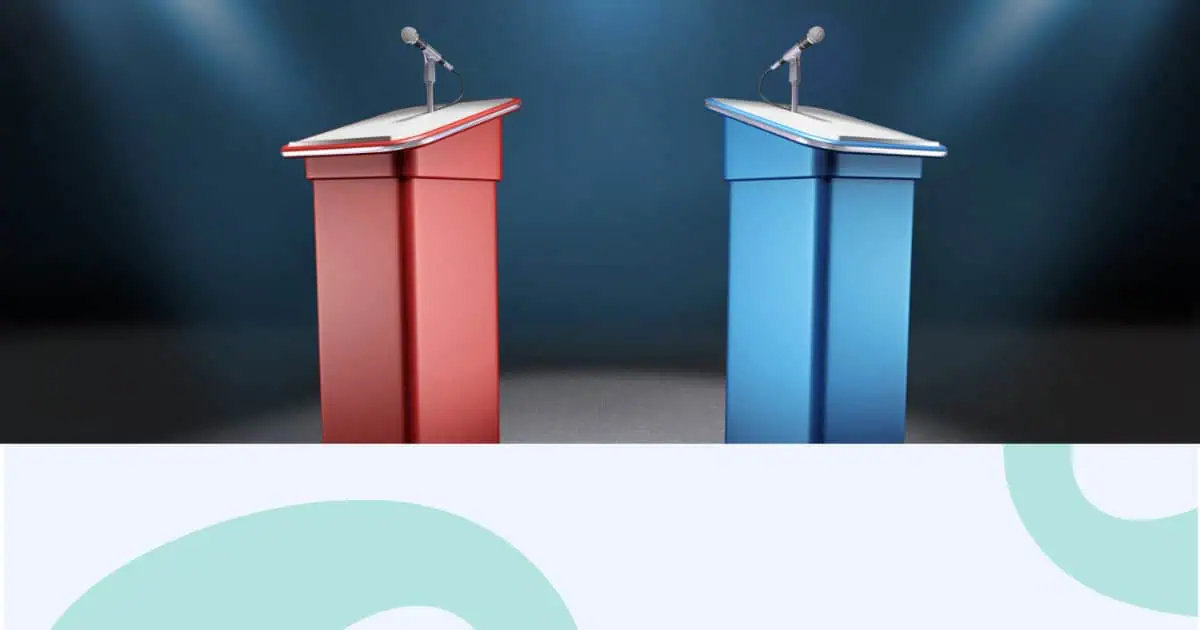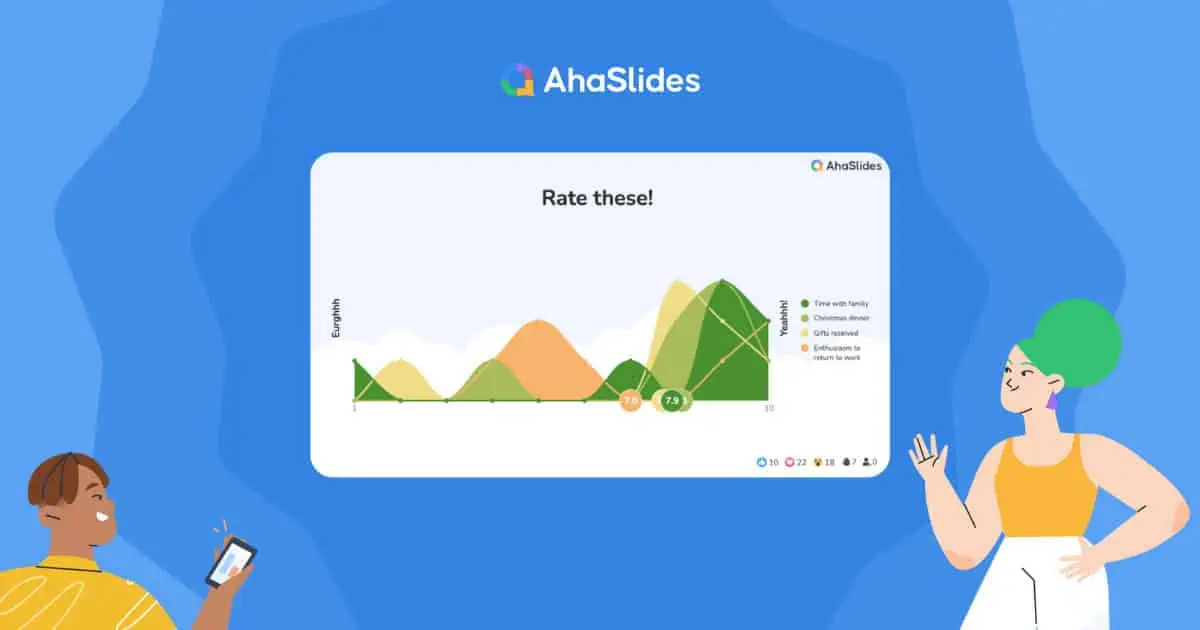Streiten ist ein großes, großes Thema. Wenn Sie noch nie gestritten haben, kann es überwältigend sein, darüber nachzudenken, was passieren wird und wie Sie vermeiden können, vor allen völlig ahnungslos dazustehen.
Es gibt viel zu lernen, bevor Sie den Mut aufbringen, auf das Podium zu treten. Aber keine Sorge; dieser Leitfaden über wie man für Anfänger debattiert gibt Ihnen die Schritte, Tipps und Beispiele, die Sie brauchen, um Ihre nächste Debatte zu meistern. Schauen wir uns also diese tollen Debattentipps an!
Inhaltsverzeichnis
- 7 Schritte zum Aufbau einer Debatte für Anfänger
- 10 Tipps für neue Debattierer
- 6 Debattenstile
- 2 Beispiele für Debatten
- Weitere Tipps mit AhaSlides
Wie eine Debatte für Anfänger funktioniert (in 7 Schritten)
Bevor Sie sich damit befassen, wie Sie Ihre Argumente wie ein Profi formulieren, müssen Sie wissen, wie eine Debatte für Anfänger funktioniert. Sehen Sie sich diese 7 Schritte zu einer Debatte für Neulinge an und erfahren Sie, was Sie dabei tun müssen. Dann werden Sie vollständig verstehen, wie Sie ein besserer Debattierer werden!
1. Der Zweck ist entschieden

Da wir Debatten an vielen Orten und in vielen Situationen durchführen können, beispielsweise in Schulen, bei Firmenmeetings, Podiumsdiskussionen oder in politischen Gremien, ist es wichtig, dass zuerst der Hauptzweck der Debatte festgelegt wird. Dies kann einen klaren Überblick über die Planung und Organisation der Debatten geben, da später viele Details zu bearbeiten sind, die alle aufeinander abgestimmt sein müssen.
Zunächst wird der Moderator folgende Frage beantworten: Was sind die Ziele dieser Debatte?
Wenn Sie beispielsweise an einer Schülerdebatte teilnehmen, sollten die Ziele dieselben sein wie die Ihrer Unterrichtsstunde. Das kann beispielsweise sein, das kritische Denken und die Redegewandtheit der Schüler zu fördern. Bei der Arbeit kann es darum gehen, zu entscheiden, welche von zwei Ideen man verfolgen möchte.
2. Die Struktur ist gewählt
Wenn Sie sich fragen, wie man gut debattiert, brauchen Sie eine Struktur. Es gibt viele Variationen von Debattenstrukturen und mehrere Formate innerhalb dieser. Bevor Sie sich auf eine Debatte vorbereiten, ist es wichtig, dass Sie zunächst einige grundlegende Begriffe kennen, die in vielen gängigen Debattentypen verwendet werden ...
- Betreff - Jede Debatte hat ein Thema, das formal als Bewegung or AuflösungDas Thema kann eine Aussage, eine Politik oder eine Idee sein. Es hängt vom Rahmen und Zweck der Debatte ab.
- Two Teams - Positiv (unterstützt den Antrag) und Negative Gedanken und (gegen den Antrag). In vielen Fällen besteht jedes Team aus drei Mitgliedern.
- Richter or Wertungsrichter: Die Leute, die die Qualität der Argumente anhand der Beweise und der Leistung der Debattierer beurteilen.
- Zeitnehmer - Die Person, die die Zeit im Auge behält und die Teams stoppt, wenn die Zeit abgelaufen ist.
- Beobachter - Es können Beobachter (Zuschauer) an der Debatte teilnehmen, diese dürfen sich jedoch nicht einmischen.
Für eine Anfängerdebatte haben die Teams nach Erhalt des Antrags Zeit, sich vorzubereiten. Die Positiv Das Team beginnt die Debatte mit seinem ersten Redner, gefolgt vom ersten Redner aus dem Negative Gedanken und Mannschaft. Dann geht es an den zweiten Lautsprecher in der Positiv Team, zurück zum zweiten Sprecher in der Negative Gedanken und Mannschaft und so weiter.
Jeder Redner wird zu der in den Debattenregeln festgelegten Zeit sprechen und seine Punkte präsentieren. Denken Sie daran, dass nicht alle Debatten enden mit Team Negative Gedanken und; manchmal Team Positiv wird zum Abschluss aufgefordert.
Da Sie wahrscheinlich neu in diesem Bereich sind, finden Sie den Debattenprozess für Anfänger unten. Es ist leicht verständlich und kann in vielen verschiedenen Arten von Debatten verwendet werden.
3. Der Debattenplan wird erstellt
Damit die Debatte reibungslos abläuft, hat der Moderator einen Plan, der so detailliert wie möglichSie sollten Ihnen diesen Plan mitteilen, da er Ihnen dabei hilft, alles zu visualisieren und Sie davon abhält, vom Thema abzukommen, was bei einer Anfängerdebatte sehr leicht passieren kann.
Hier ist eine einfache Checkliste mit den Inhalten eines Plans:
- Der Zweck der Debatte
- Die Struktur
- Wie der Raum eingerichtet wird
- Die Zeitleiste und das Timing für jeden Zeitraum
- Formelle Debattenregeln und Anweisungen für die Redner und Juroren
- Notizvorlagen für die Rollen
- Die Zusammenfassung, um die Debatte zu schließen, wenn sie endet
4. Der Raum ist eingerichtet
Die Umgebung ist für eine Debatte von entscheidender Bedeutung, da sie die Leistung des Redners in gewissem Maße beeinflussen kann.
Ihre Debatte sollte in einer möglichst professionellen Atmosphäre stattfinden. Es gibt viele Möglichkeiten, einen Debattenraum einzurichten, aber egal, für welche Einrichtung Sie sich entscheiden, alles dreht sich um den „Rednerbereich“ in der Mitte. Hier findet die ganze Magie der Debatte statt.
Jeder Sprecher, der die beiden Teams vertritt, steht während seines Zuges im Sprecherbereich und kehrt dann zu seinem Platz zurück, wenn er fertig ist.
Unten ist eine beliebtes Layout-Beispiel für eine Anfängerdebatte:

Natürlich besteht immer die Möglichkeit, eine Debatte online abzuhalten. Es kann sein, dass Sie bei einer Online-Debatte für Anfänger nicht die gleiche Atmosphäre spüren, aber es gibt einige Möglichkeiten, die Diskussion aufzupeppen:
- Hintergrundanpassung: Jede Rolle kann einen anderen Zoom-Hintergrund haben: Gastgeber, Zeitnehmer, Wertungsrichter und jedes Team. Dies kann helfen, die Rollen jedes Teilnehmers zu unterscheiden und einen gewissen Stolz auf die gegebene Rolle hervorrufen.
- Unterstützende Geräte:
- Timer: Timing ist in einer Debatte wichtig, besonders für Neulinge beim ersten Mal. Ihr Moderator kann entscheiden, Ihr Tempo mit einem Timer auf dem Bildschirm zu verfolgen (obwohl der Zeitnehmer in den meisten Debatten nur signalisiert, wenn noch 1 Minute oder 30 Sekunden übrig sind).
- Soundeffekte: Denken Sie daran, dass dies nur eine Debatte für Anfänger ist. Sie können von Ihrem Moderator erwarten, dass er die Atmosphäre auflockert, indem er klatschende Soundeffekte wenn ein Redner seinen Vortrag beendet.
5. Die Teams werden ausgewählt
Die Teams werden eingeteilt in Positiv und Negative Gedanken und. Normalerweise werden die Teams und die Sprecherpositionen innerhalb dieser Teams zufällig ausgewählt, sodass Ihr Moderator a verwenden kann Spinnerrad um den Prozess spannender und ansprechender zu gestalten.

Nachdem die beiden Teams ausgewählt wurden, wird der Antrag bekannt gegeben und Sie erhalten etwas Zeit zur Vorbereitung, idealerweise eine Stunde.
In dieser Zeit wird der Moderator auf viele verschiedene Ressourcen hinweisen, damit die Teams den Kontext und die Probleme verstehen können, um stärkere Argumente zu machen. Je mehr Sie wissen, desto heftiger die Debatte.
6. Die Debatte beginnt
Jede Art von Debatte erfordert ein anderes Format, und es kann viele Variationen geben. Nachfolgend finden Sie eine sehr beliebte Version, die für Anfänger in jeder Debatte verwendet werden kann.
Jedes Team hat bei dieser Debatte vier Redebeiträge, daher sind 6 oder 8 Sprecher am besten geeignet. Bei 6 Sprechern sprechen zwei Redner zweimal.
| Rede | Zeit | Verantwortlichkeiten der Debattierer |
| 1. Bejahendes Konstruktiv | 8 Minuten | Stellen Sie die Bewegung und ihren Standpunkt vor Geben Sie ihre Definitionen von Schlüsselbegriffen an Präsentieren Sie ihre Argumente zur Unterstützung des Antrags |
| 1. Negativ Konstruktiv | 8 Minuten | Nennen Sie ihre Argumente gegen den Antrag |
| 2. Bejahendes Konstruktiv | 8 Minuten | Legen Sie weitere Argumente zur Unterstützung des Antrags und der Meinungen des Teams dar Konfliktfelder erkennen Beantworten Sie Fragen des negativen Sprechers (falls vorhanden) |
| 2. Negativ Konstruktiv | 8 Minuten | Legen Sie weitere Argumente zur Unterstützung des Antrags und der Meinungen des Teams dar Konfliktfelder erkennen Beantworten Sie Fragen des negativen Sprechers (falls vorhanden) |
| 1. negative Widerlegung | 4 Minuten | Legen Sie weitere Argumente gegen den Antrag dar und verstärken Sie die Meinungen des Teams Konfliktfelder erkennen Beantworten Sie Fragen des positiven Sprechers (falls vorhanden) |
| 1. bejahende Widerlegung | 4 Minuten | Verteidige die Positiv Argumente des Teams und entkräften die Gegenargumente, ohne neue Argumente oder Informationen hinzuzufügen |
| 2. negative Widerlegung (Schlusserklärung) | 4 Minuten | Haben Sie eine zweite Widerlegung und abschließende Erklärungen |
| 2. bejahende Widerlegung (Schlusserklärung) | 4 Minuten | Haben Sie eine zweite Widerlegung und abschließende Erklärungen |
???? Je nach Regelwerk kann es vor den Widerlegungen zu einer kurzen Vorbereitungszeit kommen.
Sie können ein Videobeispiel dieses Formats sehen hier unten an.
7. Beurteilen Sie die Debatte
Jetzt müssen die Juroren an die Arbeit. Sie müssen die Debatten und die Leistung jedes einzelnen Debattierers beobachten und dann bewerten. Dies sind einige der Dinge, auf die sie bei Ihrer Leistung achten werden …
- Organisation und Übersichtlichkeit - Die Struktur Ihrer Rede. Ist es sinnvoll, sie so zu strukturieren, wie Sie es getan haben?
- Inhalt - Diese Argumente, Beweise, Kreuzverhöre und Gegenargumente bringen Sie vor.
- Liefer- und Präsentationsstil – Wie Sie Ihre Argumente rüberbringen, einschließlich Sprach- und Körpersprache, Augeninhalt und Tonfall.
10 Tipps für neue Debattierer
Niemand kann alles von Anfang an beherrschen, und wenn Sie noch nie in Ihrem Leben debattiert haben, ist es nicht einfach, damit anzufangen. Nachfolgend finden Sie 10 schnelle Tipps lernen, wie man effektiv debattiert, und können bei jeder Debatte mit den Neulingen mitmachen.
#1 - Vorbereitung ist der Schlüssel - Recherchieren Sie zum Thema viel um nicht nur Hintergrundinformationen, sondern auch Vertrauen zu gewinnen. Dies kann unerfahrenen Debattierern helfen, die Themen besser zu verstehen, um gute Widerlegungen zu starten, dann ihre Argumente zu formulieren, Beweise zu finden und zu vermeiden, in Kaninchenlöcher zu geraten. Jeder Debattierer sollte alles in Punkten darlegen (idealerweise 3 Punkte für 3 Argumente), um die Ideen besser zu ordnen und das „Gesamtbild“ seiner Rede zu sehen.
#2 - Alles beim Thema bleiben - Eine der Sünden beim Debattieren ist es, vom Thema abzuschweifen, da dadurch wertvolle Redezeit verschwendet und das Argument geschwächt wird. Achten Sie auf die Gliederung und die Hauptpunkte, um sicherzustellen, dass sie dem Thema folgen und die richtigen Probleme ansprechen.
#3 - Machen Sie Ihre Argumente anhand von Beispielen deutlich - Beispiele machen Ihre Debattensätze überzeugender und die Leute sehen die Dinge klarer, wie fehlen uns die Worte. Beispiel unten...

#4 - Versuchen Sie, wie die Gegner zu denken - Denken Sie beim Überarbeiten von Ideen an die Argumente, die die Gegenseite vorbringen könnte. Identifizieren Sie einige davon und schreiben Sie eine Mindmap mit Gegenargumenten auf, die Sie anbieten könnten, wenn sie do am Ende diese Punkte machen.
#5 - Haben Sie eine starke Schlussfolgerung - Beenden Sie die Debatte mit ein paar guten Sätzen, die zumindest die wichtigsten Punkte zusammenfassen können. In vielen Fällen schließen die Debattierer gerne mit einem kraftvollen Schluss, mit einem poetisch gestalteten Satz, der dafür sorgt, dass kleiner Tropfen Moment (Sehen Sie sich unten ein Beispiel dafür an).
#6 - Sei selbstbewusst (oder täusche es vor, bis du es schaffst!) - Eine der wichtigsten Voraussetzungen für eine bessere Debatte ist die richtige Stimmung. Debattierer müssen von dem, was sie sagen, überzeugt sein, denn Prahlerei hat großen Einfluss auf Richter und Beobachter. Natürlich gilt: Je besser Sie sich vorbereiten, desto selbstbewusster sind Sie.
#7 - Sprechen Sie langsam - Ein sehr häufiges Problem von Debattieranfängern ist ihre Sprechgeschwindigkeit. Meistens ist sie beim ersten Mal viel zu schnell, was sowohl bei den Zuhörern als auch beim Sprecher Angst macht. Atmen Sie tief durch und sprechen Sie langsam. Sie bekommen vielleicht weniger heraus, aber das, was Sie hervorbringen, wird Gewicht haben.
#8 - Verwenden Sie Ihren Körper und Ihr Gesicht - Die Körpersprache kann Ihre Argumente untermauern und Selbstvertrauen ausdrücken. Schauen Sie Ihrem Gegner in die Augen, nehmen Sie eine gute Haltung ein und kontrollieren Sie Ihre Mimik (werden Sie nicht zu aggressiv), um Aufmerksamkeit zu erregen.
#9 - Hören Sie aufmerksam zu und machen Sie sich Notizen - Die Debattierenden müssen auf jede Rede und Idee achten, um dem Tempo zu folgen, ihre Teamkollegen zu unterstützen und die Gegner besser zu widerlegen. Notizen können sehr hilfreich sein, da sich niemand jeden Punkt merken kann, den er widerlegen oder weiter ausführen muss. Denken Sie daran, nur die wichtigsten Punkte zu notieren.
#10 - Vermeiden Sie billige Aufnahmen - Konzentrieren Sie sich auf die Argumente Ihres Gegners und widerlegen Sie diese, nicht die des Gegners selbst. Kein Debattierer sollte andere beleidigen; das zeugt von mangelnder Professionalität und wird Ihnen definitiv einen schlechten Ruf einbringen.
6 Arten von Anfängerdebatten
Es gibt viele Debattenstile mit unterschiedlichen Formaten und Regeln. Einige davon gründlich zu kennen, kann Anfängern helfen, den Prozess zu verstehen und zu verstehen, was sie tun müssen. Hier sind einige gängige Debattenstile, die Ihnen in Ihrer ersten Debatte begegnen könnten!
1. Politische Debatte - Dies ist ein gängiger Typ, der viel Forschung erfordert. Die Debatte dreht sich darum, ob eine bestimmte Richtlinie umgesetzt werden soll oder nicht, normalerweise in Form von zwei Personen oder mehreren Teams. Politische Debatte wird in vielen Schulen verwendet, weil es praktisch ist und die Regeln leichter zu befolgen sind als bei anderen Typen.
2. Parlamentarische Debatte - Dieser Debattenstil basiert auf dem britischen Regierungsmodell und den Debatten im britischen Parlament. Zuerst von britischen Universitäten übernommen, ist dies nun der offizielle Debattenstil vieler großer Debattierwettbewerbe wie der World University Debating Championship und der European Universities Debating Championship. Solche Debatten sind geistreicher und kürzer als die traditionellen Datenschutzrichtlinien Debatte, wodurch es für viele Fälle geeignet ist, von Mittelschulen bis hin zu Universitäten.

3. Öffentliche Forumsdebatte - Bei diesem Stil diskutieren zwei Teams über einige „heiße“ und kontroverse Themen oder aktuelle Ereignisse. Zu diesen Themen haben Sie wahrscheinlich bereits eine Meinung, daher ist diese Art der Debatte zugänglicher als eine Datenschutzrichtlinien Debatte.
4. Lincoln Douglas Debatten. - Dies ist ein offener Debattenstil, bei dem sich Teilnehmer gegenseitig diskutieren. Der Name geht auf eine berühmte Debattenreihe zwischen den US-Senatskandidaten Abraham Lincoln und Stephen Douglas aus dem Jahr 1858 zurück. Bei diesem Stil konzentrieren sich die Debattierenden auf tiefgründigere oder philosophischere Fragen, hauptsächlich zu wichtigen Themen.
5. Spontan Argumentation - Zwei Debattierer diskutieren über ein bestimmtes Thema. Sie müssen ihre Argumente in sehr kurzer Zeit formulieren und ohne große Vorbereitung schnell auf die Ideen ihrer Gegner reagieren. Dies erfordert starke Argumentationsfähigkeiten und kann helfen, das Selbstvertrauen zu stärken und Lampenfieber zu überwinden.
6. Kongress- Debatten. - Dieser Stil ist eine Simulation der US-Legislative, bei der die Debattierenden Kongressmitglieder nachahmen. Sie debattieren über Gesetzesentwürfe, darunter Gesetzesentwürfe (Gesetzesvorschläge) und Resolutionen (Stellungnahmen). Der simulierte Kongress stimmt dann über die Verabschiedung des Gesetzes ab und stimmt weiterhin für oder gegen das Gesetz.
2 Beispiele für Debatten
Hier haben wir zwei Beispiele einiger Debatten, damit Sie besser sehen können, wie sie ablaufen ...
1. Debatte im britischen Parlament
Dies ist ein kurzer Ausschnitt aus einer Debatte zwischen der ehemaligen britischen Premierministerin Theresa May und dem ehemaligen Labour-Vorsitzenden Jeremy Corbyn. Die dynamische Atmosphäre und die hitzigen Diskussionen sind typisch für diese Art von hitzigen Debatten. May beendete ihre Rede mit einer so starken Aussage, dass sie sogar viral ging!
2. Die Debattierer
Schülerdebatten erfreuen sich an Schulen zunehmender Beliebtheit; manche gut geführten Debatten können sogar so spannend sein wie die von Erwachsenen. Dieses Video zeigt eine Folge der englischsprachigen vietnamesischen Debattiershow „The Debaters“. Die Schüler debattierten in einem üblichen 3-gegen-3-Format über den Antrag „Wir applaudieren Greta Thunberg“.







